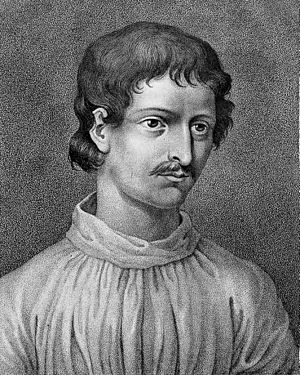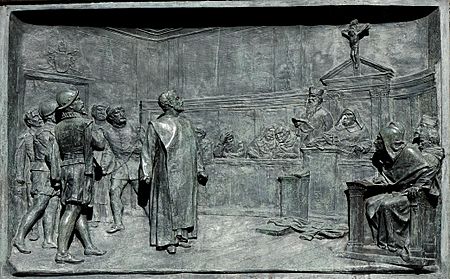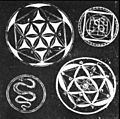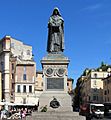Giordano Bruno facts for kids
Quick facts for kids
Giordano Bruno
|
|
|---|---|

Portrait from Opere di Giordano Bruno, published in 1830
|
|
| Born |
Filippo Bruno
January or February 1548 Nola, Kingdom of Naples
|
| Died | 17 February 1600 (aged 51–52) |
| Cause of death | Execution by burning at the stake |
| Era | Renaissance |
| School | Renaissance humanism Neopythagoreanism |
|
Main interests
|
Cosmology |
|
Notable ideas
|
Cosmic pluralism |
|
Influences
|
|
Giordano Bruno ( Latin: Iordanus Brunus Nolanus; born Filippo Bruno, January or February 1548 – 17 February 1600) was an Italian philosopher, poet, cosmological theorist and esotericist.
Bruno proposed that the stars were distant suns surrounded by their own planets (exoplanets). He also believed that these planets might foster life of their own, a position known as cosmic pluralism. Bruno insisted that the universe is infinite and could have no center. For publishing beliefs contrary to Roman Catholic dogma, he was burnt at the stake as a heretic by the Inquisition of the Roman Catholic Church.
After his death, he gained considerable fame, being particularly celebrated by 19th- and early 20th-century commentators who regarded him as a martyr for science, although most historians agree that his heresy trial was not a response to his cosmological views but rather a response to his religious and afterlife views. Bruno's case is still considered a landmark in the history of free thought and the emerging sciences.
In addition to cosmology, Bruno also wrote extensively on the art of memory, a loosely organized group of mnemonic techniques and principles.
Contents
Life
Born Filippo Bruno in Nola (a comune in the modern-day province of Naples, then part of the Kingdom of Naples) in 1548. He was the son of Giovanni Bruno (1517- c. 1592) , a soldier, and Fraulissa Savolino (1520-?). In his youth he was sent to Naples to be educated. He was tutored privately at the Augustinian monastery there, and attended public lectures at the Studium Generale. At the age of 17, he entered the Dominican Order at the monastery of San Domenico Maggiore in Naples, taking the name Giordano, after Giordano Crispo, his metaphysics tutor. He continued his studies there, and ordained a priest in 1572 at age 24. During his time in Naples, he became known for his skill with the art of memory and on one occasion traveled to Rome to demonstrate his mnemonic system before Pope Pius V and Cardinal Rebiba.
His talents attracted the benevolent attention of the king Henry III; Bruno subsequently reported:
"I got me such a name that King Henry III summoned me one day to discover from me if the memory which I possessed was natural or acquired by magic art. I satisfied him that it did not come from sorcery but from organized knowledge; and, following this, I got a book on memory printed, entitled The Shadows of Ideas, which I dedicated to His Majesty. Forthwith he gave me an Extraordinary Lectureship with a salary."
Bruno then went to France, where he published several works on mnemonics, including De umbris idearum (On the Shadows of Ideas, 1582), Ars memoriae (The Art of Memory, 1582), and Cantus circaeus (Circe's Song, 1582; described at Circe in the arts#Reasoning beasts § Notes). All of these were based on his mnemonic models of organized knowledge and experience. Bruno also published a comedy summarizing some of his philosophical positions, titled Il Candelaio (The Torchbearer, 1582). In the 16th century dedications were, as a rule, approved beforehand, and hence were a way of placing a work under the protection of an individual. Given that Bruno dedicated various works to the likes of King Henry III, Sir Philip Sidney, Michel de Castelnau (French Ambassador to England), and possibly Pope Pius V, it is apparent that he had risen sharply in status and moved in powerful circles.
Nonetheless, Bruno's taste for free thinking and forbidden books soon caused him difficulties.
During his stay in England (1583–1585), Bruno completed and published some of his most important works, the six "Italian Dialogues", including the cosmological tracts La cena de le ceneri (The Ash Wednesday Supper, 1584), De la causa, principio et uno (On Cause, Principle and Unity, 1584), De l'infinito, universo et mondi (On the Infinite, Universe and Worlds, 1584) as well as Lo spaccio de la bestia trionfante (The Expulsion of the Triumphant Beast, 1584) and De gli eroici furori (On the Heroic Frenzies, 1585). Some of these were printed by John Charlewood.
Bruno was granted permission to teach at Wittenberg, where he lectured on Aristotle for two years. However, with a change of intellectual climate there, he was no longer welcome, and went in 1588 to Prague, where he obtained 300 taler from Rudolf II, but no teaching position. He went on to serve briefly as a professor in Helmstedt, but had to flee again in 1590 when he was excommunicated by the Lutherans.
During this period he produced several Latin works, dictated to his friend and secretary Girolamo Besler, including De Magia (On Magic), Theses De Magia (Theses on Magic) and De Vinculis in Genere (A General Account of Bonding). All these were apparently transcribed or recorded by Besler (or Bisler) between 1589 and 1590. He also published De Imaginum, Signorum, Et Idearum Compositione (On the Composition of Images, Signs and Ideas, 1591).
In 1591 he was in Frankfurt, where he received an invitation from the Venetian patrician Giovanni Mocenigo, who wished to be instructed in the art of memory, and also heard of a vacant chair in mathematics at the University of Padua. At the time the Inquisition seemed to be losing some of its strictness, and because the Republic of Venice was the most liberal state in the Italian Peninsula, Bruno was lulled into making the fatal mistake of returning to Italy.
He went first to Padua, where he taught briefly, and applied unsuccessfully for the chair of mathematics, which was given instead to Galileo Galilei one year later. Bruno accepted Mocenigo's invitation and moved to Venice in March 1592. For about two months he served as an in-house tutor to Mocenigo, to whom he let slip some of his heterodox ideas. Mocenigo denounced him to the Venetian Inquisition, which had Bruno arrested on 22 May 1592. Among the numerous charges of blasphemy and heresy brought against him in Venice, based on Mocenigo's denunciation, was his belief in the plurality of worlds. Bruno defended himself skillfully, stressing the philosophical character of some of his positions, denying others and admitting that he had had doubts on some matters of dogma. The Roman Inquisition, however, asked for his transfer to Rome. After several months of argument, the Venetian authorities reluctantly consented and Bruno was sent to Rome in January 1593.
Imprisonment, trial and execution, 1593–1600
During the seven years of his trial in Rome, Bruno was held in confinement, lastly in the Tower of Nona. Some important documents about the trial are lost, but others have been preserved, among them a summary of the proceedings that was rediscovered in 1940. The numerous charges against Bruno, based on some of his books as well as on witness accounts, included:
- holding opinions contrary to the Catholic faith and speaking against it and its ministers;
- holding opinions contrary to the Catholic faith about the Trinity, the divinity of Christ, and the Incarnation;
- holding opinions contrary to the Catholic faith pertaining to Jesus as the Christ;
- holding opinions contrary to the Catholic faith regarding the virginity of Mary, mother of Jesus;
- holding opinions contrary to the Catholic faith about both Transubstantiation and the Mass;
- claiming the existence of a plurality of worlds and their eternity;
- believing in metempsychosis and in the transmigration of the human soul into brutes;
- dealing in magics and divination.
Bruno defended himself as he had in Venice, insisting that he accepted the Church's dogmatic teachings, but trying to preserve the basis of his cosmological views. In particular, he held firm to his belief in the plurality of worlds, although he was admonished to abandon it. His trial was overseen by the Inquisitor Cardinal Bellarmine, who demanded a full recantation, which Bruno eventually refused. On 20 January 1600, Pope Clement VIII declared Bruno a heretic, and the Inquisition issued a sentence of death.
Bruno was burnt at the stake as a heretic by the Inquisition in 1600. His ashes were thrown into the Tiber river.
All of Bruno's works were placed on the Index Librorum Prohibitorum in 1603.
The measures taken to prevent Bruno continuing to speak have resulted in his becoming a symbol for free thought and speech in present-day Rome, where an annual memorial service takes place close to the spot where he was executed.
Physical appearance
The earliest likeness of Bruno is an engraving published in 1715 and cited by Salvestrini as "the only known portrait of Bruno". Salvestrini suggests that it is a re-engraving made from a now lost original. This engraving has provided the source for later images.
The records of Bruno's imprisonment by the Venetian inquisition in May 1592 describe him as a man "of average height, with a hazel-coloured beard and the appearance of being about forty years of age".
Cosmology
In 1584, Bruno published two important philosophical dialogues (La Cena de le Ceneri and De l'infinito universo et mondi), in which he anticipates some of the arguments of Galilei on the relativity principle.
With the Earth move [...] all things that are on the Earth. If, therefore, from a point outside the Earth something were thrown upon the Earth, it would lose, because of the latter's motion, its straightness as would be seen on the ship [...] moving along a river, if someone on point C of the riverbank were to throw a stone along a straight line, and would see the stone miss its target by the amount of the velocity of the ship's motion. But if someone were placed high on the mast of that ship, move as it may however fast, he would not miss his target at all, so that the stone or some other heavy thing thrown downward would not come along a straight line from the point E which is at the top of the mast, or cage, to the point D which is at the bottom of the mast, or at some point in the bowels and body of the ship. Thus, if from the point D to the point E someone who is inside the ship would throw a stone straight up, it would return to the bottom along the same line however far the ship moved, provided it was not subject to any pitch and roll."
Bruno's infinite universe was filled with a substance—a "pure air", aether, or spiritus—that offered no resistance to the heavenly bodies which, in Bruno's view, rather than being fixed, moved under their own impetus (momentum).
The universe is then one, infinite, immobile.... It is not capable of comprehension and therefore is endless and limitless, and to that extent infinite and indeterminable, and consequently immobile.
Bruno's cosmology distinguishes between "suns" which produce their own light and heat, and have other bodies moving around them; and "earths" which move around suns and receive light and heat from them. Bruno suggested that some, if not all, of the objects classically known as fixed stars are in fact suns. According to astrophysicist Steven Soter, he was the first person to grasp that "stars are other suns with their own planets."
Bruno wrote that other worlds "have no less virtue nor a nature different from that of our Earth" and, like Earth, "contain animals and inhabitants".
During the late 16th century, and throughout the 17th century, Bruno's ideas were held up for ridicule, debate, or inspiration.
Legacy
Giordano Bruno Foundation
The Giordano Bruno Foundation (German: Giordano-Bruno-Stiftung) is a non-profit foundation based in Germany that pursues the "Support of Evolutionary Humanism". It was founded by entrepreneur Herbert Steffen in 2004. The Giordano Bruno Foundation is critical of religious fundamentalism and nationalism.
Giordano Bruno Memorial Award
The SETI League makes an annual award honoring the memory of Giordano Bruno to a deserving person or persons who have made a significant contribution to the practice of SETI (the search for extraterrestrial intelligence). The award was proposed by sociologist Donald Tarter in 1995 on the 395th anniversary of Bruno's death. The trophy presented is called a Bruno.
Astronomical objects named after Bruno
The 22 km impact crater Giordano Bruno on the far side of the Moon is named in his honor, as are the main belt Asteroids 5148 Giordano and 13223 Cenaceneri; the latter is named after his philosophical dialogue La Cena de le Ceneri ("The Ash Wednesday Supper") (see above).
Other remembrances
Radio broadcasting station 2GB in Sydney, Australia is named for Bruno. The two letters "GB" in the call sign were chosen to honor Bruno, who was much admired by Theosophists who were the original holders of the station's licence.
Works
- De umbris idearum (On the Shadows of Ideas, Paris, 1582)
- Cantus circaeus (The Incantation of Circe or Circe's Song, Paris, 1582)
- Ars memoriae (The Art of Memory, Paris, 1582)
- De compendiosa architectura et complento artis Lulli (A Compendium of Architecture and Lulli's Art, 1582)
- Candelaio (The Torchbearer or The Candle Bearer, 1582; play)
- Ars reminiscendi (The Art of Memory, 1583)
- Explicatio triginta sigillorum (Explanation of Thirty Seals, 1583)
- Sigillus sigillorum (The Seal of Seals, 1583)
- La cena de le ceneri (The Ash Wednesday Supper, 1584)
- De la causa, principio, et uno (Concerning Cause, Principle, and Unity, 1584)
- On the Infinite Universe and Worlds (De l'infinito universo et mondi, 1584)
- Spaccio de la bestia trionfante (The Expulsion of the Triumphant Beast, London, 1584)
- Cabala del cavallo Pegaseo (Cabal of the Horse Pegasus, 1585)
- De gli eroici furori (The Heroic Frenzies, 1585)
- Figuratio Aristotelici Physici auditus (Figures From Aristotle's Physics, 1585)
- Dialogi duo de Fabricii Mordentis Salernitani (Two Dialogues of Fabricii Mordentis Salernitani, 1586)
- De somni interpretatione (Dream Interpretation, 1586)
- Animadversiones circa lampadem lullianam (Amendments regarding Lull's Lantern, 1586)
- Lampas triginta statuarum (The Lantern of Thirty Statues, 1586)
- Centum et viginti articuli de natura et mundo adversus peripateticos (One Hundred and Twenty Articles on Nature and the World Against the Peripatetics, 1586)
- De Lampade combinatoria Lulliana (The Lamp of Combinations according to Lull, 1587)
- De progressu et lampade venatoria logicorum (Progress and the Hunter's Lamp of Logical Methods, 1587)
- Oratio valedictoria (Valedictory Oration, 1588)
- Camoeracensis Acrotismus (The Pleasure of Dispute, 1588)
- De specierum scrutinio (1588)
- Articuli centum et sexaginta adversus huius tempestatis mathematicos atque Philosophos (One Hundred and Sixty Theses Against Mathematicians and Philosophers, 1588)
- Oratio consolatoria (Consolation Oration, 1589)
- De vinculis in genere (Of Bonds in General, 1591)
- De triplici minimo et mensura (On the Threefold Minimum and Measure, 1591)
- De monade numero et figura (On the Monad, Number, and Figure, Frankfurt, 1591)
- De innumerabilibus, immenso, et infigurabili (Of Innumerable Things, Vastness and the Unrepresentable, 1591)
- De imaginum, signorum et idearum compositione (On the Composition of Images, Signs and Ideas, 1591)
- Summa terminorum metaphysicorum (Handbook of Metaphysical Terms, 1595)
- Artificium perorandi (The Art of Communicating, 1612)
Collections
- Jordani Bruni Nolani opera latine conscripta (Giordano Bruno the Nolan's Works Written in Latin), Dritter Band (1962) / curantibus F. Tocco et H. Vitelli
Related pages
Images for kids
-
Woodcut from "Articuli centum et sexaginta adversus huius tempestatis mathematicos atque philosophos", Prague 1588
See also
 In Spanish: Giordano Bruno para niños
In Spanish: Giordano Bruno para niños
- Fermi paradox
- List of Roman Catholic scientist-clerics








